It’s difficult to find a good action film. It’s even more difficult to make a good action thriller. And still more difficult is to make an action thriller that not only tells a story but delivers a psychological character study that speaks to differences and similarities which compromise those shades of grey, the crossing of lines of good and bad, right and wrong. Thanks to writer/director CHRISTIAN GUDEGAST and producer TUCKER TOOLEY, DEN OF THIEVES IS all that and more.
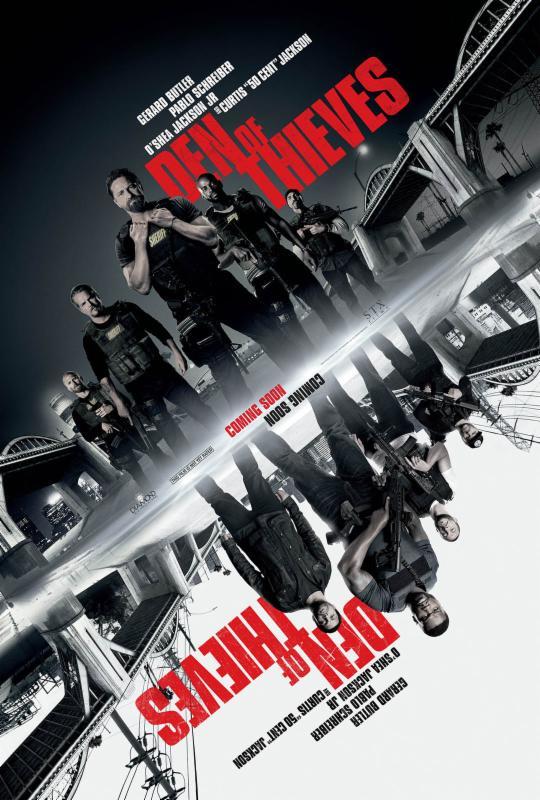
A testosterone-fueled filled roller coaster of high octane intensity, DEN OF THIEVES is in many ways a modern day western; a tale of the Outlaws versus the Regulators. Two types and groups of men who are each bound by brotherhood and family and while on opposite sides of the law are, in many ways, very much the same. The Regulators, led by Gerard Butler’s “Big Nick” are the elite of the elite in the Los Angeles Major Crimes unit. Joining Butler’s crew are Kaiwi Lyman-Messereau, Moe McRae, Brian Van Holt and Maurice Compte. The Outlaws, led by Pablo Schreiber’s “Merrimen” are former military and/or former criminal element, all connected by life experiences. Joining Schreiber are, among others, Curtis “50 Cent” Jackson, O’Shea Jackson, Jr, and Evan Jones. Here, the Outlaws are about to pull off the granddaddy of all bank heists – the Federal Reserve Bank in Los Angeles. Nick and the Major Crimes Unit have been trying to nab these guys for some time knowing in their guts that after a string of small jobs all with the same signature, something big was in the air. They just didn’t know how big.
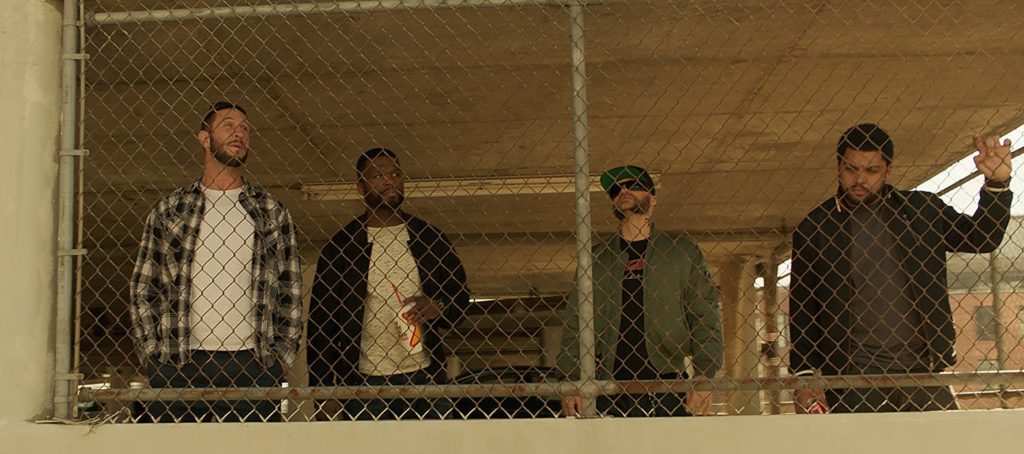
It is always exciting to see a film with as much authenticity and attention to detail as that which Gudegast brings to play with DEN OF THIEVES. Thanks to meticulous research, the characters explode on screen with depth and texture, but each with an ambiguity that is engaging and compelling, while the visuals are not only intense and exciting but visceral, almost tactile in nature, telling their own layer of the story.
While Tooley has a wide breadth of producing experience across a multiplicity of genres throughout his career, he is no stranger to action or character studies. Just look at “Act of Valor” from Scott Waugh and “Mouse” McCoy, or “Felon” from Ric Roman Waugh. As in those Tooley produced films, with DEN OF THIEVES, intensity, authenticity and character reign supreme. And although this may be Gudegast’s first feature directorial, he brings years of cinematic experience to the table, all of which shows on screen thanks to a keen directorial eye and hand that goes beyond the exacting technical aspects of action, weaponry, and armament, but into costuming, tattoos, and showcasing sides and areas of Los Angeles rarely if ever explored on screen; and doing it while shooting in Atlanta.
Cool and casual, writer/director CHRISTIAN GUDEGAST and producer TUCKER TOOLEY were thick as thieves in their collaboration on DEN OF THIEVES, something I discovered as we sat down for this exclusive interview talking the mechanics of bringing this 14-year journey to fruition with grit and authenticity.
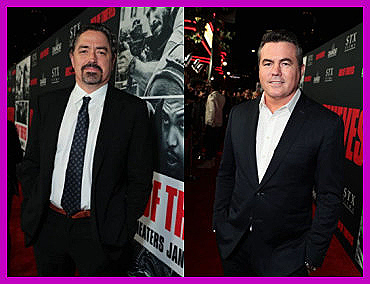
Gentlemen, I am absolutely thrilled with this film. To see the level of authenticity is here is amazing. I love the fact you mention all the cop bars! I can’t tell you how many I’ve been in, but enough. [laughing]
CHRISTIAN GUDEGAST: They’re real. Ever been to the Shortstop, with the bullet holes?
I have not!
CG: Go!
TUCKER TOOLEY: Christian Gudegast can give you the tour of police bars in Los Angeles.
When I was working in law for a number of years and was working on an LAPD potential class action, many guys in Northeast Division, they’d haul me off to cop bars to hang out.
CG: Northeast. Those guys are no joke. Right now, that’s the toughest right now. Northeast is the toughest by far. They have the Avenues Gang and it’s really, really bad.
Pacific Division LAPD used to be when the Mar Vista Gardens right there off of Culver Boulevard was in full gang swing.
CG: Bingo. You know what’s up. The ghost town of Venice.
TT: That’s where my mom was on the police commission at that point.
But when it comes to DEN OF THIEVES, beyond the authenticity and what makes this story exciting is the story itself and that there has never been a successful Federal Reserve heist. There was the 1922 Denver Mint heist of the delivery truck with $200,000 but not the action bank. There have been attempts. Everyone calls the recent $81 million cyber heist, a heist. That’s not a heist, not a physical heist, where you go in, steal the money, have that in your hand. The concept in and of itself is amazing. I love it.
TT: Came right from inside his brain.
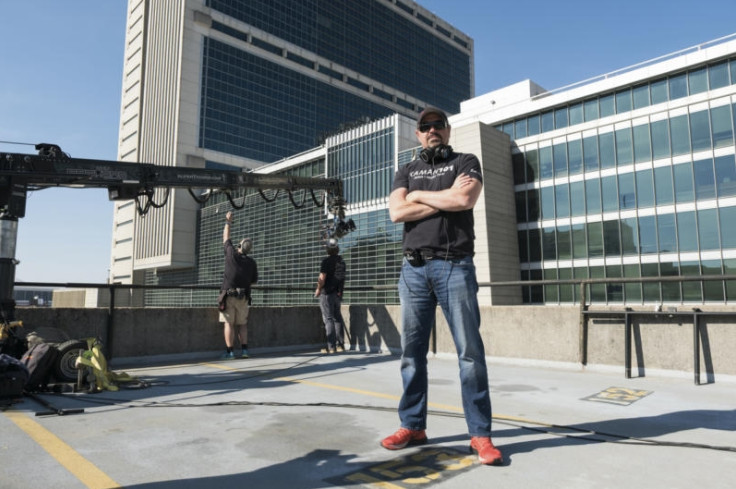
What a fertile brain, Christian! But I’m curious how this marriage between the two of you helped with this authenticity, because of your dad, Tucker and the Federal Reserve in Los Angeles.
CG: We’re also both from LA. Tucker and I both are LA boys, so we know the city really well, and we talked about starting a business together and what became “A Man Apart”, originally that initial script was totally different, the vibe was totally different. We always wanted to do great LA crime films because there are a few great ones, but there aren’t that many. We think of most great crime films as East Coast based because those filmmakers are from New York. But there’s “Heat”, “To Live and Die in LA”, “Jackie Brown”, “City of Industry” is pretty cool, “End of Watch”, “Collateral”. . .
TT: “Colors.”
CG: “Colors”. Unbelievable. But there aren’t that many. And specifically, the black experience has been covered with “Menace II Society” and “Boyz n the Hood”, great. And the Latino experience has been covered with “American Me” and “End of Watch”, sort of the Rampart world. But most of the crime shows, like “Collateral”, it’s always like Rampart, Rampart, Rampart. That’s great. But the reality of the criminal world, where all the real Mafias and cartels are operating, is the South Bay. So that’s that’s why the movie’s set there. It’s really from the LAX south, El Segundo, Compton, Lakewood, Long Beach, Hawthorn, Lennox, Torrance, San Pedro, that’s where when you ride along with cops, you’re going along with the Major Crime’s guy, that’s where they’re operating the whole time.
Because of the port, there’s all different freeways, because the mix of ethnicities. so what “Straight Outta Compton” did for Compton, this does for all the cities around it. Again, also that world is where MMA is from, and skateboarding, and Dogtown and Z-Boys. It’s culturally very specific, like the stuff the guys wear, the hats, the skateboarding gear. The baggy pant thing. The whole baggy pant thing comes from gangsters from that area. Comes from leaving county jail. They’ve taken your belt, you don’t have a belt anymore. You walk outside, your pants are hanging around your waist, and that’s where the whole baggy pant aesthetic came from. It’s culturally very specific and strong, and we wanted to set a movie there, so that’s how it came to be.

Logistically, when we get into the Federal Reserve scenes, people don’t go into the Federal Reserve, so it’s a mystery to everybody, and you unlock some of the keys there.
TT: We do, to some degree, as you obviously have researched and know my dad was involved on the building committee of the Federal Reserve, and they do give tours. We got a slightly more extensive tour than the normal tour. That said, there was a lot we couldn’t do when we were in the Federal Reserve. But it gives you a sense, as Christian just said in the press conference, it gives you a sense. The most overwhelming thing to me was aggregating all this money on one place, in terms of, if you are gonna dream up a heist that could work, and you were one of these guys in this film, that’s the only target that you would, that’s the biggest heist.
CG: It’s the ultimate, it’s the Super Bowl.
TT: It’s the ultimate, it’s the pan ultimate place to have a heist. I always loved, and Christian really, it was the Federal Reserve when he wrote the script. So when I read it, that’s what was being robbed, and it was being robbed in the very way that it’s in the movie now. There’s not anything that’s really different, other than, I think, what we were able to do, from the tour, is really the specificity that is in the rest of the film, with the other cast in the rest of the film, with the neighborhoods, with the detail and wardrobe. We were able to take that, because we didn’t have clarity on that going into it, and being able to take that tour in the Federal Reserve gave us that specificity, the color of the uniforms that the count room guys wear, the security guys, how they’re positioned.
CG: The layout, the radios, how the whole machine is oiled.
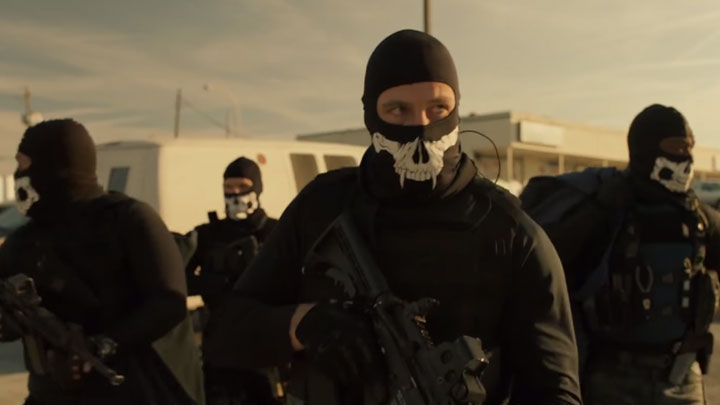
Did you build your own Federal Reserve for this? It’s incredible.
CG: Yes, we had to. We had to commit to memory obviously, and when you go down in there, again because of that plexiglass wall thing, it just takes your breath away. It’s not like anything you’ve ever seen, it has a very fascinating aura when you’re down there, the feeling you have when you’re walking through those hallways. We just tried to recreate it to the best of our ability, we just tried to get every detail down that we could.
TT: There’s always on every movie a big production issue, and this was the primary production issue for us. Because Christian, when we were first there early and we did location scouts, we found the greatest exterior drive-in place, and it just felt so broad and big. And then we couldn’t find an interior that could match it, and then when we had to find a place to go build that interior, it was almost impossible in Atlanta to find it.
CG: All the stages were taken, the movie “Black Panther” was shooting there.
TT: “Avengers.” And so all the big space where we could actually build this was taken, and it wasn’t until very late, like maybe a week before we started shooting, a couple days before we started shooting, that we found this place to build the Federal Reserve. And then I remember on the tour of the Federal Reserve, when we came out, Kara Lindstrom our production designer, ran to our car and she had to remember the specifics and she wrote everything down that she saw. And then building that, five, six, seven months later, at least a couple months. And that was a challenge. Having that match the bigness of the exterior of the Federal Reserve was our biggest concern, could we do that, and ultimately I think it really works.
It really does. The scope of the outside of the building, and underground it fits that scope, it really does.
CG: I’m not saying this is in our movie, it looks pretty damn close to the real thing, it really does. It looks pretty damn close.
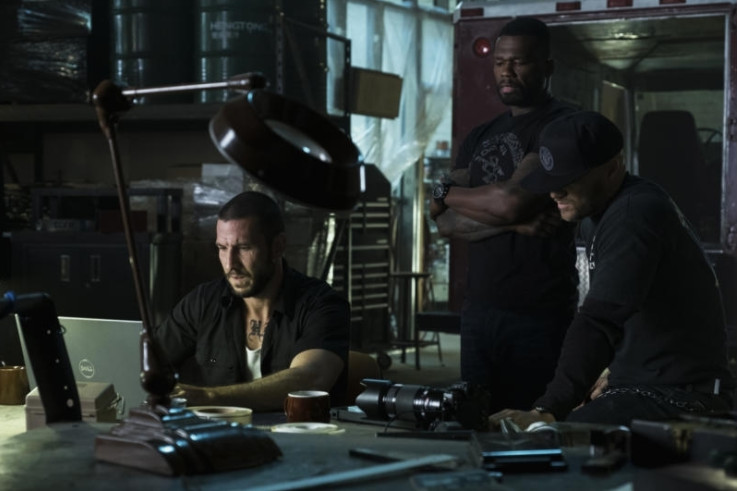
And Tucker, you’ve worked with him before, but then you bring Terry Spacey in as your cinematographer. Christian, how did you and Terry go about designing your visual tonal bandwidth, because it’s very specific, your interiors, your use of color, exteriors, and your use of light, sometimes it’s a natural light, but it also looks like you’re adding and punctuating to give a tinge to the light to take away from what would be light in Atlanta, to make it more conducive to Los Angeles, smoggy L.A.?
CG: 100%. I photographed the entire film prior to doing it, so even way before prep, I basically went out with my 35mm camera to the actual locations and basically took pictures of the entire world. Every location, all the characters, what they wore in the world, so it was basically animating that. It was just taking, the location of Atlanta for example. The locations department in Atlanta, no fault of their own really, but they didn’t find one location. We found every single location driving the city. We were there for months driving it because Atlanta looks nothing like Los Angeles. It’s all brick, it’s basically a forest, it’s at 1,200 feet, there’s zero parallels.
Albuquerque’s maybe a little bit better, but as far as a city, it looks nothing like it. At first it was like, “Holy shit, this is gonna be tough”, because not only were we shooting for LA, but we’re shooting for very specific parts of LA, and we’re looking at the picture like, “It’s got to look like that, and it doesn’t look like that at all.” Eventually we were able to find, I think honestly, the only location in the city that looked like LA, and we dress them certain ways and obviously shot them at certain angles and everything. But then Terry and I did a bunch of camera tests and everything. We just tried to the whole time have this LA look, this tobacco-y kind of, a lot of grain in it, and we wanted it to be saturated but grainy, to have an almost reversal stock kind of look.
Then we had a few rules of engagement. So, the gangsters, the criminals, we always basically shot either locked off on sticks or on a Steadicam. And with Big Nick and the cops, because the gangsters are much more in control, they control their environment, and we did the same thing in the Federal Reserve, but with Big Nick and the cops their lives were wild, they’re getting divorced, they fucking drink, they’re hungover, that was all handheld. They would go in and out of frame, and it was much more chaotic. We tried to be pretty disciplined with that. And then when they came together, if you look closely we would say, “Who has the power in the scene?” And we would intro the scene with that look, so if it’s the Outlaws, the criminals, it would be Steadicam, then we’d transition into a handheld,
As we did in Pico Rivera [band robbery] for example. We go in with Nick into the bank, it’s Steadicam pulling him in, and then we slowly transitioned into the handheld, because Nick and the guys were of course outside, because that’s where the worlds really collide. That was our self-imposed mandate to shoot it.
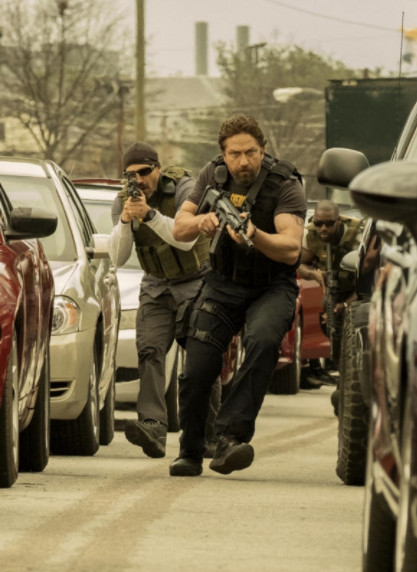
It’s fabulous, it really comes off. And the way that you’re lensing the specific action sequences, such as the Alameda corridor sequence, absolutely outstanding framing and camera work there, getting POVs, down on the ground, we stay eye-level, which I think is so key of really drawing the audience into the spider-web.
CG: We only did one geography shot overhead, only one, just to get the geography, to get a sense of the distance, because it was so specific. We storyboarded, we blocked it. In prep, we had all the cars laid out, and the distance, and how many cars in between them when they’re shooting, so we really wanted to establish the geography very specifically so you knew exactly the stakes. How they had to aim, what direction, how far away they were, the distance they had to travel, so that’s the only geography shot beside the long lens ones. We really drilled down on that more than anything, we had to too, because we had mother fucker weather problems, it was freezing, it was sleeting, it was snowing. We had an active shooter, it was nuts. And we had obviously, like anything else, every production, we had to rush, rush, rush, so we had to get it done as quick as we can, so we preplanned the shit out of it.
It shows on the screen, I got to tell you, it shows. Because these visuals, these sequences, are stellar, they really are.
CG: Thank you. Personally, we’re not fans of the style of shooting that so many action films, where it’s long lens, long lens, long lens. Tony Scott’s the master of it, but everybody else copies it. It’s covering from five different angles to super long lenses, and let the action play out, but you lose the geography. Kathryn Bigelow does the opposite. She’s amazing. You understand the geography of what you’re seeing. That’s what it’s got to be. We have to understand where everybody is, understand the physicality, understand where they have to get to, where they’re going, it just makes it much more visceral.
That’s the only way you get connected to the characters. If you don’t connect, because you’ve got the multiplicity of characters here, and you have to relate the all of them in some fashion, long lens would not do that, wide angle would not do that. I love what you did from a visual standpoint.
CG: Exactly, otherwise it becomes arbitrary. Thank you very much, I appreciate that.

The other part of this film that is outstanding, your sound design, whoa! Who did you bring in as your sound designer, and what were your discussions and considerations?
CG: There were a lot.
You can hear specific ammo flying, specific guns. This sound design is up there with what Mark Stoeckinger does on the “John Wick” movies. Amazing!
TT: Thank you.
CG: It started with our guy on set, Michael Koff. He’s one of the best in the business, so my conversations with him were, “Look, I hate looping, I hate ADR, I hate bad sound effects, we’ve got to get as much production sound as possible,” because we were crazy specific about the sounds of the guns, and all the guys did their own stunts, the sound of their grunts and movement and everything. He just mic’d the shit out of scenes, and then when we, again during the boot camp we talked about, we sent him out there, so he shot all the boot camp and listened to it. It was this huge property that had this escarpment on one end, so there was this reverb thing, it was like 300 yards away was this escarpment, so they would shoot and there would be these long delays, like, “Pow pow, pow pow pow pow pow.” And it sounded unbelievable.
Basically, he’d record sound there for two days with their training, and that was our template for all the gunfire. If you listen, it has that reverb thing going on. And then when we went into the mix, all the sound guys were like, “That’s the best production sound they’ve ever heard ever.” Then we just spent a lot of money and a lot of time in sound, because we were so specific, we wanted to get authentic, we wanted to be a soundscape, we wanted to be just total immersion. I’m a gamer too, and video games’ sound designs are insane, it’s probably better than most movies to be completely honest, and it just has to be that it is its own character. Every gun we drilled on, every single gun, what that gun sounds like, what the reverb sounds like, what that gun, what the different shell casings sound like when they hit, because of different size of shell, literally it was that specific. And Kami [Asgar] and the guys, they just crushed it, did an unbelievable job.
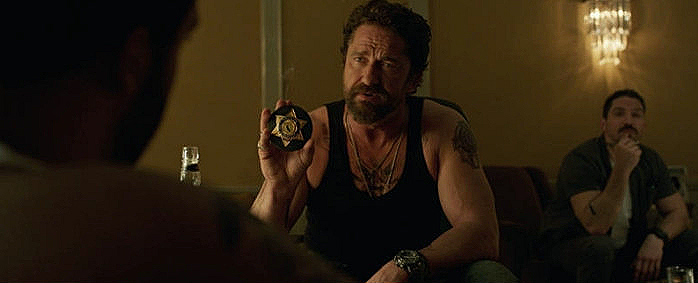
The soundscape is utterly amazing. What does all of this do to you as a producer, Tucker? How nerve-wracking or how calming is it to have a director who is this dialed into specificity and knowing what he wants, and knowing how to get it?
TT: It’s the best. First of all, this is his first time directing.
I know. I would never believe that on seeing this.
TT: Generally with a first-time director you’re very nervous about those things. I’ve known Christian, as you’ve said, we’ve been doing this, talking about this movie for the better part of a decade, if not longer. The reason, frankly, when I bought the script at Relativity, that I bought it was only because Christian and I wanted him to direct it. Most people are very freaked out about a first time director. But when you have someone who wrote it, and I already know Christian as a filmmaker is incredible, I knew that you can tell just by sitting down with him in the specificity with which he talks about character and story and look and feeling, it’s a blessing. Before we got to set, he had directed the movie in his head every day for 14 years, basically.
CG: Pretty much.
TT: So he knew exactly what he wanted. Really the challenge then becomes, we’re not in LA, we’re shooting in Atlanta, how do we make Atlanta look like LA? The challenge becomes this thing that I’ve pictured in my head, and I know the real location and I know the real people for 14 years, and this is not what I’m looking at right here. So how do we turn what I’m looking at right here into the thing that I’ve pictured for 14 years? It becomes a different challenge, but never was there a concern, “Will he do a great job directing?” If you talk to any actors, and you were in the press conference, they all adore him and love him because again, it’s that specificity that an actor looks in character, in the cup they pick up, the jewelry they’re wearing, the gun they’re holding, how they’re holding it. It’s that specificity that allows an actor to really drill down and nail a performance. And Gerry [Butler], for years when we would have these meetings with Gerard, Christian would go, “Do that again, do that again, that’s Big Nick, that’s Big Nick, do that, keep doing that.” And he would go practice and he would come back, and it would be more Big Nick, and he became Big Nick over the course of many years. When we got there on the day, he didn’t have to discover Big Nick, he was Big Nick.
CG: We brought in the real dudes, every character was based on somebody that we knew, we brought them to Atlanta. We’re like, “Okay, meet him, you’re him.” And they would hang out with them and mimic them. When you watch TV shows like “Narcos” or any great streaming thing when it’s interesting, when you watch them, if you watch episodes back to back, you can see how that’s the challenge with TV because there’s not as much time. You can see the actor by episode four he’s starting to get his groove on with the character. It’s so rare that you’re able to nail it from the beginning because the reality is you’re just finding somebody when you’re starting the production. We didn’t want to do that, so we front loaded. In prep, we had the guys way early, so by the time we were there every guy was just absolutely just on point. They’d been living in that character for so long, they were ready to go. And again, as Tucker said, the training was just so specific, it was just like, “You are this person, this is what you wear, this is how you shoot your gun, this is the car you drive, this is where you’re from, this is who you’re married to.” Every single guy had that, so we made it easier on them, it leaves less guesswork They’re given the accouchements of what their character is, and then they bring themselves into it. It was a very cool experience, it was great.
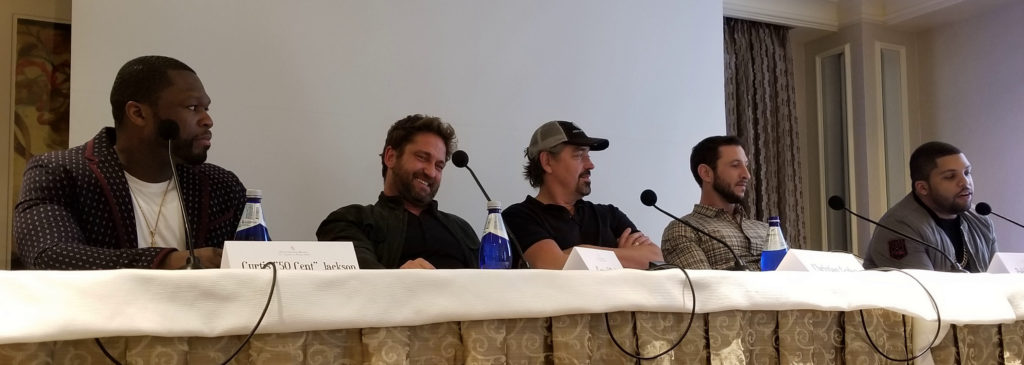
I have to say, when you mention the costume and the rings, that was never more obvious than with Gerard as Nick, with the rings, and especially when a bullet comes whizzing by and the hand. That comes so into play with his whole movement of his hands, and how he even holds the gun because of the jewelry. You look at him hold a gun in this film as opposed to holding a gun as Mike Banning in the “Olympus” trilogy, and it’s totally different. The frame is the same, but it’s totally different, because of the weight of that heavy, heavy silver jewelry.
CG: Yeah, it’s true. I love how close you watched the film, I’m impressed. Good for you.
TT: You’re the exact person that we made this movie for. Someone who appreciates the detail that went into it, because all of that was thought through, none of that was, “Oh yeah, just put whatever jewelry you want on him.” We had a picture, I remember like it was yesterday, up in the office of a real undercover cop. It was Jay Dobyns who’s our guy. But there’s a picture of him and he’s sitting there doing something, and he’s got all that jewelry on-
CG: He’s smoking a cigarette. He’s going like this [mimicking movement], and his other hand’s up here, and Gerry’s like, “Wow.” I’m like, “That’s you.” Done. The picture told a thousand words.
TT: And that was every department from the ground up, with the specificity.
CG: We had a wall. It would be like, “Tony Z, Murph, Bosco.” It would be their car, their gun, the jewelry they wear, the necklaces they wear, the shoes he wears, literally, his T-shirts, what gas mask he has. Every fucking thing. So we’d bring the actors in, and be like, okay, it’s like their locker. It’s like “Okay, here you go, that’s you.” Terry Anderson, the costume designer, was amazing. He called and we would go through brands, “You’re gonna call Skin Industries, you got to call Boom.” And he called Da Hui, and he called the companies and just got, the companies were like, “Fuck yeah, fucking Gerard Butler!” and they’d send all the gear. It was cool.
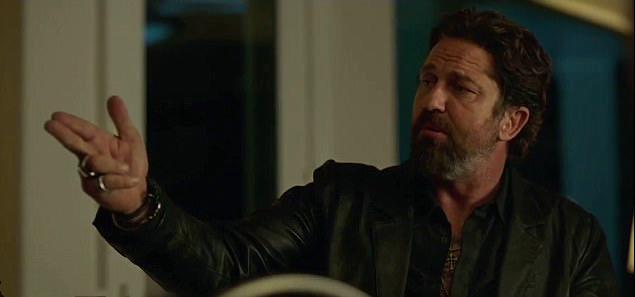
And you follow through with tattoos as well. One final question for you both. Because this was your first film, Christian, and you’re working with this “first-time” filmmaker Tucker, what did you learn about yourself that you can now take with you, in the making of this film, that you can now take forward into future films? And for you, Tucker, is there anything new that you learned in working with an experienced first timer, shall we say?
CG: Doesn’t feel like [first film], but yes. We talk about this a lot and I’ll tell you, the number one thing I learned is our instincts were right. We just followed through with what we always knew, and it worked.
TT: The big thing that I can think of right off the bat is there were many points along the way where we could have made the movie with different casting, but it just didn’t feel right. After 14 years, you want to make the movie, you want all this to go into something, so we were predisposed to say yes to many actors, but we just never felt it, it didn’t feel right. And even in casting the movie, when we’d sit there and look at tapes or auditions or whatever, it was always. . .
CG: Almost always!
TT: 89% of the time, instinctually on actors, on locations, on how it should be, how it shouldn’t be. We just tried to stay consistent with that. But what I learned, what I learned is that first of all there is a first time director isn’t really an accurate term for Christian because he’s directed a documentary and went to film school and directed shorts, so he’d been there before. But directing is not actually – you certainly learn a lot doing it, but it’s here [indicating the heart], and it’s in here [indicating the head], and it’s in the writing of it. That’s what counts, I’ve had plenty of directors I’ve worked with over the years, some unbelievably talented, some first timers more raw and less accomplished, but you learn that if they have it in there and they know exactly what they want, and if you’re shooting what’s on the page, you have a pretty good chance to accomplish.
CG: Yeah, shooting what’s on the page, that’s a big one. That’s the other thing I learned, and even in the cutting, some things we had to adjust. If it works on the page, that’s it. It’s like architectural plans. That’s it. Don’t fuck with it, just leave it, just do that. Because again, we spent so much time on the script, and we got it right, that means it’s right, don’t dick with it too much.
by debbie elias, exclusive interview 1/16/2018












